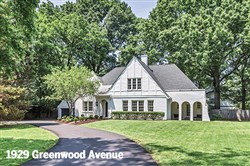VOL. 47 | NO. 30 | Friday, July 21, 2023
Can’t keep East Nashville or its home prices down

1929 Greenwood Avenue
The house located at 1929 Greenwood Avenue in East Nashville was listed by The Beacon Group of FC, a collection of agents led by the wildly successful Megan Garrett and her associate, Katie Valle, whom her managing broker Sean Simons describes as “a rising star.”
The entourage listed the house for $2.45 million and sold it for that price in a matter of days.
The house includes 4,363 square feet and was constructed on an enormous lot – 0.87 acres, twice the size of most East Nashville lots – and sold for $562 per square foot. The owners were thrilled with the sale, Simons says, and that’s no surprise since they purchased the house two years earlier for $1.01 million.
With this sale, East Nashville remains a phenomenon that refuses to fold. Not since the plagues of Egypt documented in the Old Testament has a region endured such abuse. The devastation began in 1916 when a young girl was playing with a ball of yarn and watched as the sphere rolled into the fire and became alit, she retrieved the blazing orb and cast it into the street, igniting a neighborhood-wide inferno that would rival the work of Ms. O’Leary’s cow in Chicago.
Not only did the fire destroy the residential and commercial areas of their structures, but it robbed the area of its wealth as the monied people living there followed the advice of Horace Greeley’s advice to “go west.” In Nashville’s case, that meant West End Avenue, which was soon lined with some of the most palatial mansions in the country. The few that remain feature ornate finishes with beautiful, traditional design.
Following that western migration of the wealth, the East Nashville region suffered.
The west side took a hit when parimutuel betting was outlawed and the horses and their industry were herded to the Bluegrass state to the north. To the east, the area began to show its resiliency as real estate superstar pioneers like Andy Allen and Cindy Evans began to promote the area in the 1980s. East Nashville began to add some of the trendier restaurants, and things were looking up.
The Tennessee Titans announced they would be building a stadium across the river and they would be playing there in the 1999 season. In 1998, tornadoes blew through that area and downtown. Nashville became the first major city in 20 years to be ravaged by F2 winds. It seemed every tree in sight along with almost every roof in the area was blown into the heavens.
Certainly, the residents suffered immensely as their possessions were scattered for miles and their roofless homes lay naked to the ensuing rain and winds. Things seemed bleak, and the thought of a house selling for $562 per square foot with a $2.45 million price tag seemed highly unlikely.
It was then that a young Realtor named Karen Hoff began to pour hundreds of thousands of advertising dollars into the area, promoting it in a way that drew the cultural creatives. The Titans who had languished in two unremarkable seasons, one in Memphis, a city that was angered the Oilers (at that time) had shunned it, and one at Vanderbilt, where the home team seldom wins, before moving into their East Nashville home.
Having finished three years with 8-8 records – mediocrity at its best – the Titans posted a 13-3 record during their first year in the new stadium and made it all the way to the Super Bowl, losing 23-16 to the St. Louis Rams.
Coach Jeff Fisher would coach 11 more seasons with the Titans and still holds the record for the most wins (142-120) of any head coach in franchise history.
East Nashville settled into its role as the “it” community as more and more highly rated restaurants and shops flooded into the area. Then, in 2010, the Cumberland River flooded the area.
Once again, the community persisted and remained undeterred as the “that which does kill us makes us stronger” adage prevailed.
Then, in the spring of 2020, right before the COVID pandemic, another tornado tore through East Nashville, killing 29 people. It was the sixth largest storm in terms of the estimated cost of the damage.
Yet through it all, “I Dream of Weenie,” a popular hot dog stand located in a Volkswagen bus on 11th Street, has survived.
The new owners of 1929 Greenwood, the 1930s Tudor that has seen it all, should stop in for a Flamin’ Frank. Perhaps Jill Tidwell, listed as the buyer’s broker, will treat her clients to the “Frank and to the Point” dog.
They should treat her after she landed them this deal with five bedrooms, four full bathrooms and one half bathroom.
Richard Courtney is a licensed real estate broker with Fridrich and Clark Realty, LLC, and can be reached at [email protected].